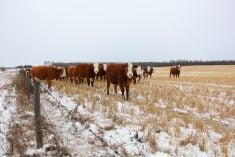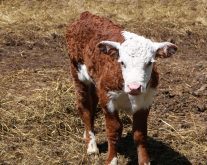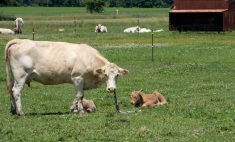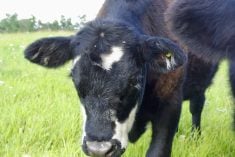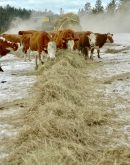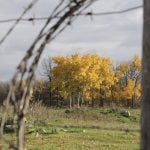Halley Adams, Lynn Thiessen and Meaghan Nawrot have many things in common, but the most prevalent one is their passion for cattle.
As students at the University of Calgary’s faculty of veterinary medicine, that is an important priority. It has brought them together from across the world to Calgary, Alta., to pursue this passion.
Adams was raised on an Angus operation of 240 head near Forestburg, in eastern Alberta. She grew up working with and showing her family’s cattle.
Read Also

Canadian Beef Check-Off Agency reports on investments and activities
The check-off agency’s work behind the scenes is what ensures cattle check-off dollars are invested wisely, accounted for transparently and deliver measurable value back to producers and importers.
Nawrot grew up on a cattle operation as well, and worked as a research technician at BASF before returning to school to get her doctorate of veterinary medicine.
Thiessen, on the other hand, was raised in Mongolia. She, too, was surrounded by livestock and says the people there are connected to the animals, which rubbed off on her.
Together, Thiessen, Adams and Nawrot worked on a research project for school and came up with a neonatal calf decision tree.
“Since we all have that cattle background, and we were interested a little bit in the calving situation, (we were) just looking at what there was for resources for calf resuscitation at that point,” Thiessen says. “We were just interested to see what the current research was. And so that kind of led into the decision tree that we put out.”
The result is a resource they have all been able to use already in their professional careers and hope others can use, as well.
Milestones for newborns
The neonatal calf decision tree highlights the major milestones a calf must reach in the first four hours of its life, as well as what should be done to reach those milestones for a calf that had an assisted birth.
After being born the milestones include: breathing on its own in 30 seconds, remaining in sternal recumbency for two to three minutes, attempting to stand at 15 minutes, and nursing on its own by four hours.
For calves that have to be pulled, producers and vets often have to take steps to ensure these calves hit these milestones. For example, on the neonatal calf decision tree, a calf that’s been pulled must immediately be put into the recovery position to clear its airways to achieve the first milestone. Another example is if the calf hasn’t achieved milestone one, which is breathing on its own, producers can poke its nose with a piece of straw and put cold water in its ear.
To create the decision tree, Adams, Nawrot and Thiessen scoured relevant research and compiled the data. Nawrot says lots of the information they found was basic stuff that people have known for a long time, but there is some new information, too. She adds that they wanted a project that would be directly applicable for producers and vets.
“I think this is a really useful resource that people can put up on the wall in their barn to refer to or use to prepare for calving season.”
Thiessen says the milestones listed on the decision tree are the same no matter what season the calves are born in, and the decision tree is applicable for any calving season. She says the only thing that may change is further monitoring after the first four hours of the calf’s life.
“Obviously, if they’re coming into winter… you’re going to have to pay attention more to their temperature and that sort of thing,” she says.
Following the first four hours of the calf’s life, they say it’s then up to the vet or the producer to decide how to monitor the calf. For example, Adams says at their operation, calves are checked two or more times a day.
“And then if one is still falling a little bit behind the others, then you maybe do want to monitor it.”
Info for vets
The resource is intended for both vets and producers. However, the second portion of the resource — talking about drugs to consider for an assisted calving — is intended more for vets.
Drugs listed in this section of the resource include doxapram, caffeine, sodium bicarbonate, intranasal oxygen and meloxicam. Lists are provided on the uses of these drugs as well as details on how they work.
However, for producers who may be using this resource, Thiessen says meloxicam is an important drug to consider. According to their resource, meloxicam increased average daily gain at seven to 10 days of age in beef calves.
“We didn’t do a lot of research on the cow side of things, but calving can be traumatic,” Thiessen says. “So having an NSAID — an anti-inflammatory — would be helpful for her as well as the calves.”
They also highlighted the importance of colostrum for a producer, saying colostrum should be used with assisted births as soon as possible.
“The sooner you can get (colostrum) in, they’re going to warm up, they’ll get energy. There’s all sorts of benefits there,” Thiessen says.
They say if a producer is going through the neonatal calf decision tree and is ever unsure, they should call a vet for assistance. Adams says there’s an added benefit in using the tree with a vet.
Relationships
As vets in training, Thiessen, Adams and Nawrot all recognize the importance os a vet-producer relationship and have kept that at the forefront of their work – including while making this resource.
“We just really recognize the importance of a relationship between producers and their veterinarians, and the importance of educational relationships,” Nawrot says. “So we thought that this is a really good tool for vets to educate each other. We got this education from other veterinarians, and then we can also pass it on to other vets and to producers.”
They say while a lot of the resource is intended for the use of vets, producers need to know the things noted in the decision tree as well, so if they do call a vet to assist them, they have the knowledge to question their vet’s decisions, if needed.
“Medicine is always changing, right?” Thiessen says.
While they all said there were times when creating the neonatal calf decision tree was hard as they had to make sure they were looking at all the current research and making it as accurate as possible, they think it came together well.
“I would say we’re very proud with how it turned out,” Adams says.





